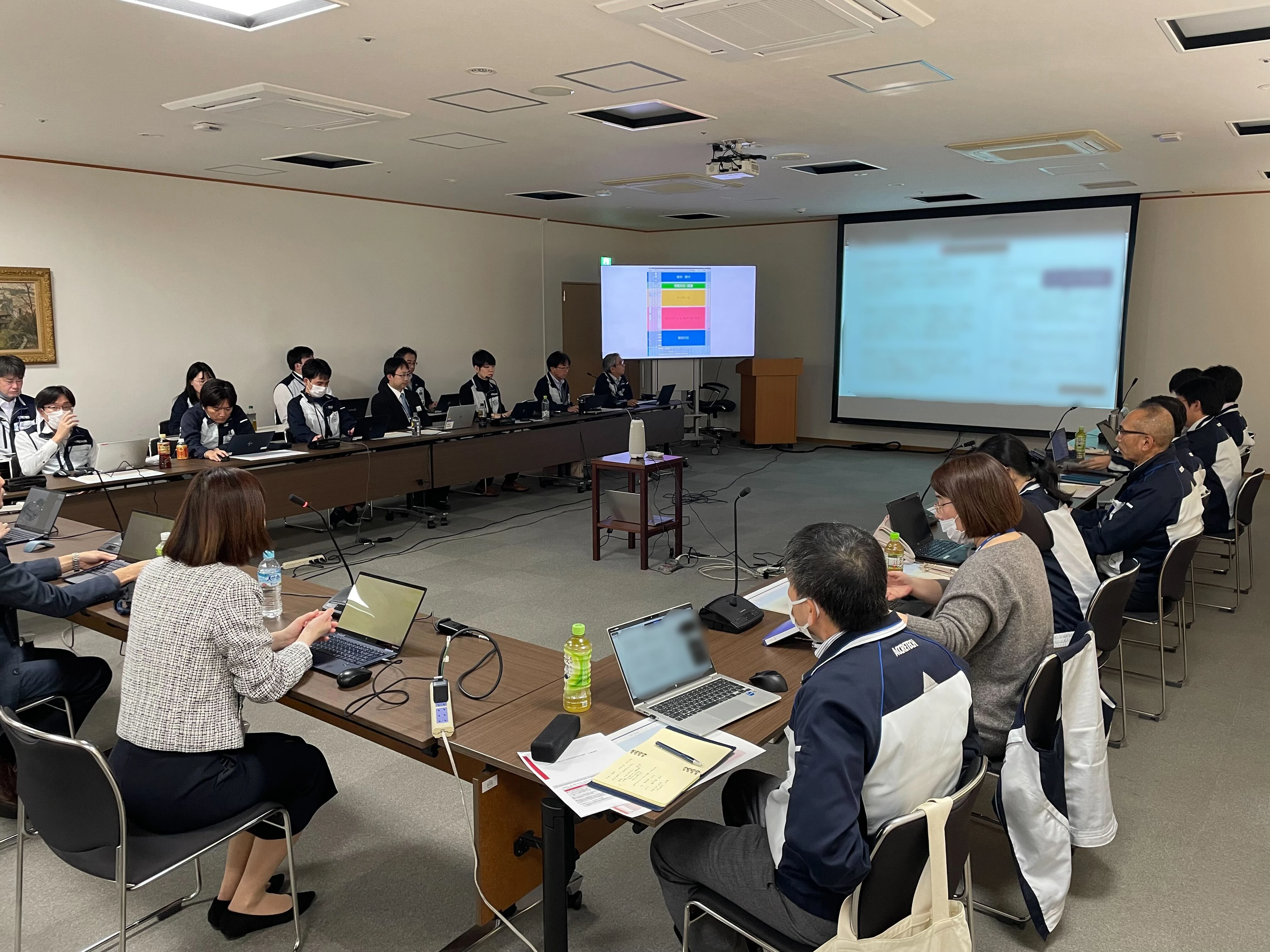Risk Management
The Tokyo Seimitsu Group has established “Risk Management Regulations” and a “Risk Management Committee,” which is headed by the president and COO, to identify and manage risks associated with business execution. Systems are in place to prevent potential risks from manifesting themselves and to prepare for crises. If a risk manifests itself, a “Risk Response Team” headed by the president and COO is immediately established to respond to that risk and take action to quickly settle the situation.
Risk Management Policy
1.
The Tokyo Seimitsu Group strives to prevent the occurrence of potential risks. If any risk has become apparent, President and COO and all employees work in unison to take prompt and prudent action.
2.
If any risk has become apparent, priority is given to protection and saving of human life.
Risk Management System
Risk Management Committee
Chairman
President and COO
Members
Committee Chairman, Audit and Supervisory Committee members, managing directors, managing executive officers, senior management, Group leaders, directors of subsidiaries, department heads, section chiefs and advisers
Risk Items and Content
The following risks are assumed to be the risks revolving around the business.
1.
Risks of occurrence of natural disasters and sudden events (earthquake, fire, storm and flood damage, terrorism, etc.)
2.
Risks caused by economic and financial market trends (business trends, fluctuation of currency rates, etc.)
3.
Risks caused by changes in customer investment trends (changes in semiconductor industry, automotive industry, etc.)
4.
Risks caused by competitor and industry trends (price competition, development competition, intellectual property rights, etc.)
5.
Risks concerning public regulations, policies and taxation (country risk, etc.)
6.
Risks concerning human resources (industrial accident, unexpected incident and accident, etc.)
7.
Risks concerning capital providers (changes in share ownership, etc.)
8.
Risks concerning IT system (IT system failure, etc.)
9.
Risks concerning the quality of products and services
10.
Risks concerning climate change
11.
Other risks associated with business execution
Business Continuity Plan
The Group has formulated a “business continuity policy” that places the highest priority on confirming and ensuring the safety of employees and their families, maintaining the supply of parts and materials necessary for customers to continue operations, and protecting human life and conducting rescue and recovery activities in the region. We review and adjust the Company’s business continuity plan (BCP) and plant BCPs on this basis. Taking changes in the external environment into account, we continue to review and detail BCPs and manuals from a practical standpoint, as well as measures to ensure the continuity of product supply and service provision, in addition to seismic reinforcement measures at the level of each department, including general affairs, production management, manufacturing, and IT.
Main initiative
Enhanced internal and external inventories of maintenance parts and consumables for semiconductor manufacturing equipment (continued from fiscal 2023)
Conducted annual DR (Disaster Recovery)* test of the Enterprise Resource Planning (ERP) system
Performed management of stockpiles and storage at each plant in accordance with “Rules for Managing Stockpiles in the Event of a Major Disaster”
Hachioji Plant
Three days worth of stockpiles for 1,583 people
Hanno Plant
Three days worth of stockpiles for 400 people
Tsuchiura Plant
Two days worth of stockpiles for 30 people
Hachioji Plant
Three days worth of stockpiles for 1,583 people
Hanno Plant
Three days worth of stockpiles for 400 people
Tsuchiura Plant
Two days worth of stockpiles for 30 people
*DR (Disaster Recovery)
Refers to the ability to mitigate damage, maintain functions, or recover and restore an information system that is seriously damaged by a natural disaster or other events. It also refers to the facilities, systems, and measures that are in place to prepare for such a situation
Safety Confirmation System
We have introduced a “Safety Confirmation System” for confirming people’s safety via mobile phones and smartphones following a disaster or accident. We explain the system to new employees and enforce early registration. We carry out operation drills twice a year (in June and December) to confirm the system’s effectiveness and to raise awareness of the system among all employees, and use the drill results to perform reviews and disseminate information. In addition to the conventional safety confirmation via e-mail, we allow the use of the safety app and messenger app as well to improve the response rate for safety confirmation e-mail and prepare for e-mail reception delays and rejections when actual safety confirmation e-mails are sent out.
Information Security
We believe that it is our responsibility to protect the information assets entrusted to us by our important customers and business partners as well as our own information assets. Accordingly, we have established the Information Security Policy as a guideline for information protection. Accordingly, we have established the Information Security Policy as a guideline for information protection. The Information Security Committee is chaired by the Head of Administration Company, and each company has a director in charge of security, a security manager, and a security subcommittee, and Group (affiliated) companies also participate in the committee. Although we have been implementing information security measures until now, unauthorized access to the servers of our Group companies was discovered in 2023. Taking this situation seriously, we have implemented the security enhancements since 2024.
Additionally, we are working to prevent leaks of confidential company information and personal information due to the expansion of the scope of conventional activities, including remote work (working from home), and provide education to improve individual employee literacy. Moving forward, we will strive to further strengthen our information security management system, including at Group companies, and work together to implement security measures.
Information Security Targets and Results
|
|
Unit |
Target |
Result |
|
Number of regular information exchange meetings on information security |
times |
38 |
37 |
|
Number of serious incidents |
incident |
0 |
0 |
|
Number of serious personal information leaks |
incident |
0 |
0 |
|
Participation in security-related seminars |
- |
Twice per year |
Twice per year |
|
Provision of specialized security-related training |
- |
Three times a year |
Three times a year |
|
Information security training participation rate |
% |
100 |
99.8 |
Information Security System Chart

A director in charge of security, a security manager, and a security subcommittee are assigned to each company, and Group (consolidated) companies also participate in the Information Security Committee.
Details of Security Enhancements (from 2024)
Contracted with an external SOC*¹ to establish a security monitoring system 24 hours a day, 365 days a year
Installed EDR*² software in all terminals in Japan and overseas to establish a system that can immediately detect and respond to suspicious behavior and cyber attacks
Introduced a globally-standardized document management platform
Started “ACCT-CSIRT*³” activities to quickly respond to incidents
Conducted a security survey based on the supplier information security standard
*¹ SOC (Security Operation Center)
A center comprised of a dedicated team that monitors and analyzes threats to information systems
*² EDR (Endpoint Detection and Response)
For the monitoring of endpoint devices such as PCs to detect and respond to suspicious behavior
*³ ACCT-CSIRT (Accretech-Computer Security Incident Response Team)
Generic name to refer to a team of experts in charge of analyzing and investigating security incidents, identifying causes, providing response support, discussing recurrence prevention measures, etc.
Establishment of the Security Operation Center (SOC) and CSIRT
To counter the threat of cyberattacks that grows increasingly serious year after year, we have a 24/7 monitoring system in place using an external SOC. We have also established the ACCT-CSIRT, which conducts security monitoring and quickly responds to any incident it detects. In fiscal 2024, we held a meeting to evaluate the capability to respond to cyber incidents. A simulation drill was conducted, based on a scenario of an internal file server being infected by a ransomware attack, to review how the individual departments responded and identify the existing concerns and problems.

Information security audit
We check the entire Tokyo Seimitsu Group to see whether each group company complies with information security-related management regulations and standards. In fiscal 2024, we audited eight overseas subsidiaries to ensure compliance with the regulations and standards.
Information security awareness campaigns
We conducted a security survey based on the supplier information security standard. The survey results and our recommended measures were put together as a handbook, which was handed to the suppliers along with a feedback report. We ask our suppliers to strengthen their abilities to address business continuity risks posed by cyberattacks and recognize information security measures as management challenges.
Environment・Society・Governance



